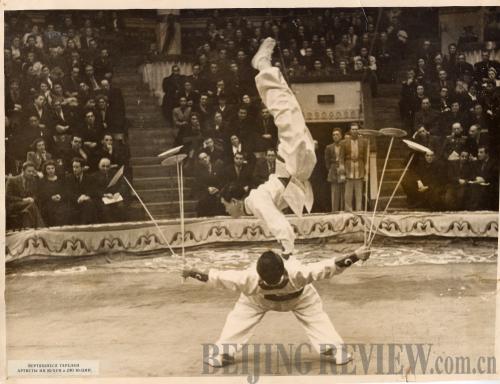|
 |
|
MARVELOUS: Chinese acrobats showcase their talents in Moscow during their visit to the former Soviet Union in 1950 (COURTESY OF CHINA NATIONAL ACROBATIC TROUPE) |
On October 28, the China National Acrobatic Troupe (CNAT) and the Beijing International Art School (BIAS) opened the gate of their mysterious headquarters, inviting the public to become better acquainted with the acrobats' lives behind the scenes.
Although those visitors know that as many as 10 years of off-stage practice are required for one minute of success on the stage, most of them were still greatly impressed by the training life of acrobats. They came to know how hard the acrobats have trained to win thundering applauses and awards, including 48 gold medals and four gold honor awards—both at home and abroad—in the last 60 years.
Making a figure
In 1950, Chinese artists were invited to perform in the former Soviet Union. Acrobats were members of the Chinese art delegation. Based on the visiting group of acrobats, CNAT, the first national acrobatic troupe of China, was founded on October 20 that year.
Moscow film studios also made the grand performance into a documentary film, which was shown in the former Soviet Union and Eastern European countries in 1951. Meanwhile, in China, the film set the bar for Chinese acrobatics. Encouraged by the successful performance, many Chinese provinces and municipalities began to establish provincial acrobatic troupes.
In recent years, many international events held in China, including the Beijing Olympic Games and the World Expo in Shanghai, were graced with a CNAT performance. In 60 years, CNAT has visited 118 countries and regions around the world; Chinese acrobatics has been the most frequently performed art in cultural exchanges between China and foreign countries.
Chinese acrobatics is said to trace back to 2,500 years ago. "Through acrobatics, one can achieve a deeper understanding of China," said Dominique Mauclair, founder of the French International Circus Festival of Tomorrow.
He is very interested in Chinese acrobatics and its long history, and affirms the Chinese Government's strong support for acrobatics. In his view, China is the paradise of acrobatics. The government, the public and the artists all attach great importance to the development of acrobatics. In recent years, Chinese acrobats have made substantial progress in traditional acrobatic skills, music, costumes, props, lighting and stage effects. The integration of art and skills improve, and Chinese acrobatics became filled with a unique charm, an ethnic style and a modern flavor.
In 1956, Mauclair, then a journalist, watched a Chinese acrobatic show for the first time, deeply fascinated by the excellent performance. In 1978, during his first visit to China, he watched an acrobatic show in a small theater. When he saw the youngest actor was just 2 years old, while the oldest was over 70, he was amazed and struck with a feeling of novelty. At that moment, he was deeply impressed by the charm of Chinese acrobatics and decided to introduce Chinese acrobatics to the world.
Through his efforts, Chinese acrobatic troupes started performing in the International Circus Festival of Tomorrow, and won awards again and again. After that, modern Chinese acrobatics began to truly emerge on the world stage. Mauclair was thus regarded as having built the bridge between Chinese acrobatics and the world people.
Toward success
CNAT attached great importance to the innovation of acrobatic shows. The acrobats ceaselessly challenged physical limitations while repeatedly completing seemingly impossible tasks.
In each show, CNAT acrobats would try to reach new heights of performance. They not only complete the tasks, but do so with beauty. This can only be achieved after thousands of failures in training.
In 2004, when CNAT was invited to take part in the International Circus Festival of Monte-Carlo, then Vice President of CNAT Sun Lili had a bold idea. Sun's idea broke the traditional act of balancing bowls on the head, a unique skill in Chinese acrobatics that was performed as far back as 2,000 years ago. Since then, shows have evolved from one-acrobat shows into multiple-acrobat performances, and the participants can both perform on the ground or in the air. However, Sun's new idea immensely increased the difficulty of the show. An acrobat first balances the bowls on her feet. As another performer tosses her in the air, she continues to balance the stack of bowls.
Initially, even Sun's colleagues thought the idea was crazy, but eventually Sun persuaded them to try. As imagined, the training was extraordinarily difficult in the beginning. Within two weeks, however, coach Li Genxi, a veteran of acrobatics at CNAT, successfully worked out five sets of action designs after comprehensively considering the difficulty and coordination of the act. The difficulty of the show, played by 13 actors, was unprecedented. Generally, an acrobatic show needs several years of practice, but performers in this show, Buckjumps and Rhythm—Pagoda of Bowls, practiced for only 10 months.
|
